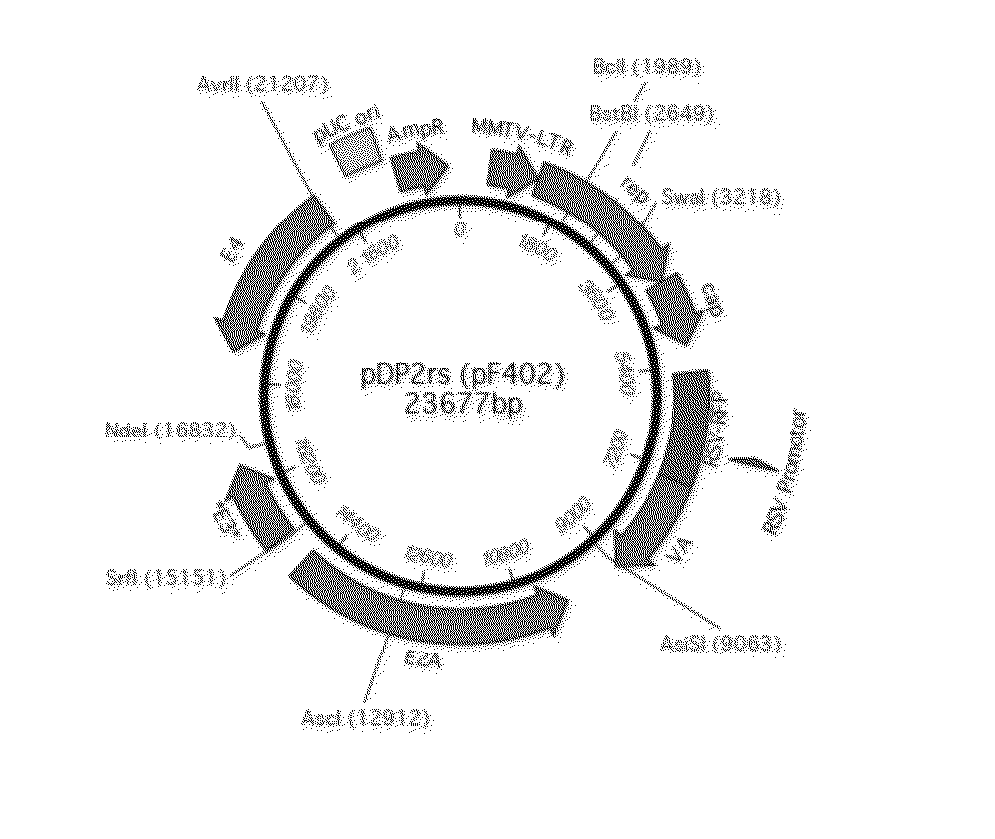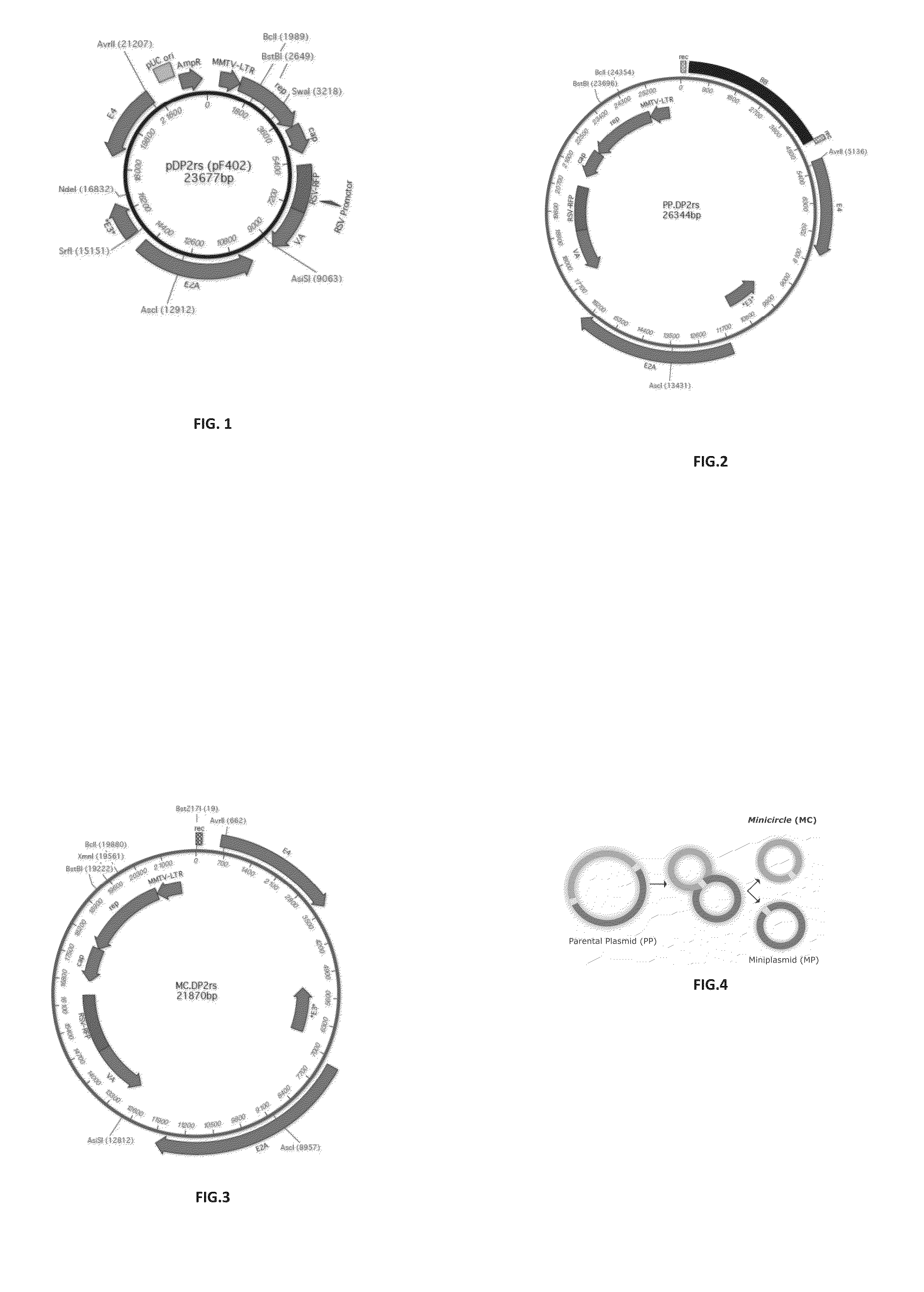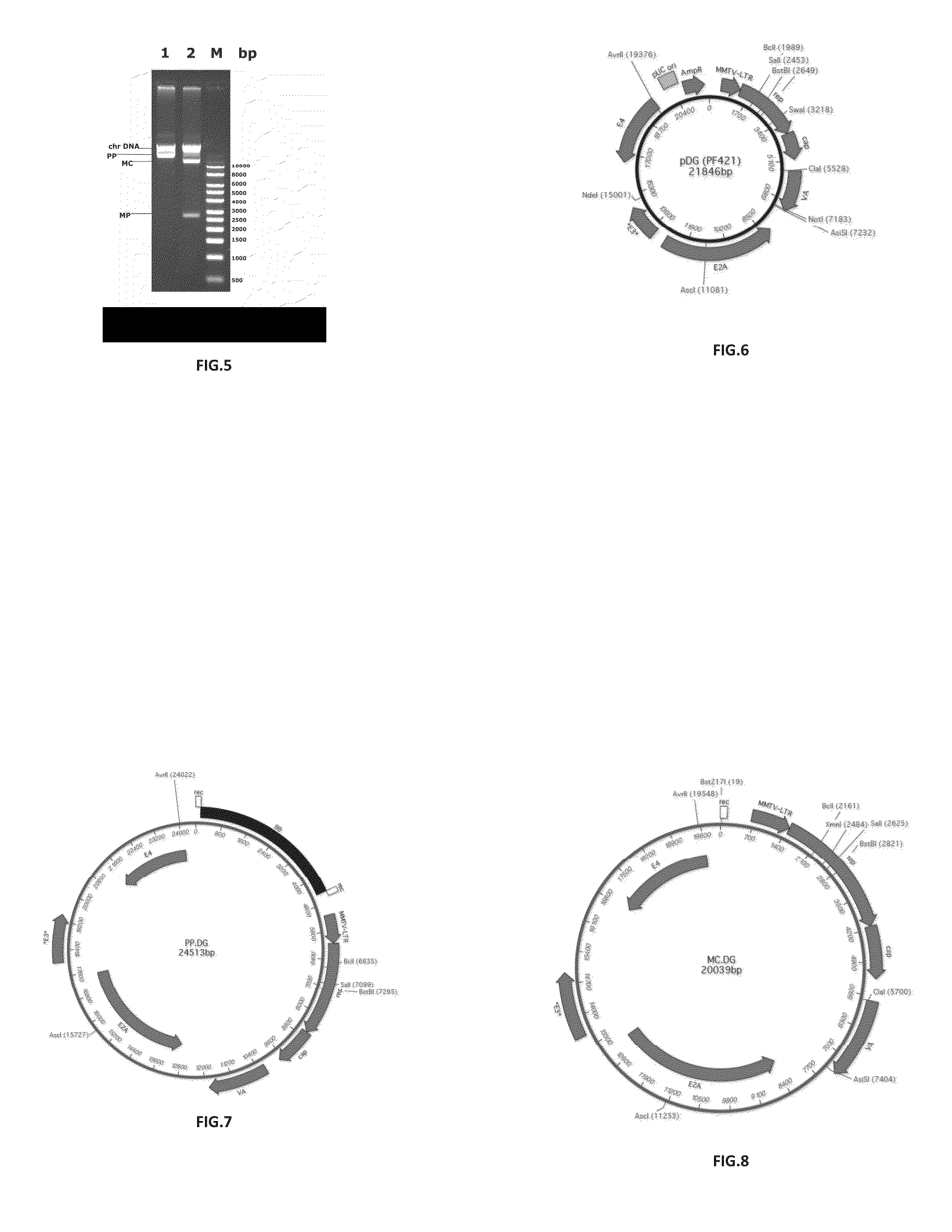Minicircles with viral expression cassettes and their use in the transformation of cells for generating recombinant virus or viral gene vectors
a technology of viral gene vectors and cassettes, applied in reverse transcribing rna viruses, biochemistry apparatus and processes, applications, etc., can solve the problems of plasmids frequently, lower transfection efficiency, and far more difficult tasks, and achieve the effect of safer preparation of viruses
- Summary
- Abstract
- Description
- Claims
- Application Information
AI Technical Summary
Benefits of technology
Problems solved by technology
Method used
Image
Examples
example 1
[0108]Construction of a Parental Plasmid (PP.DP2rs) for Minicircles Comprising the Helper / Packaging Sequences from pDP2rs
[0109]The plasmid pDP2rs (23677 bp, Article No. PF402, PlasmidFactory, Bielefeld, DE) containing several expression cassettes for the AAV helper / packaging functions, especially the cap protein of serotype 2 and a gene for red fluorescent protein (RFP) (FIG. 1. SEQ ID NO: 1) is used as starting material for the selective extraction of the region including the above-mentioned genetic characteristics. Thereby, an approx. 21.5 kb DNA fragment and an (unwanted) approx. 2 kb DNA fragment is generated through restriction digestion with PacI (Article No. R0547L, NEB, Frankfurt, Germany). The 21.5 kb fragment is purified by agarose gel electrophoresis, gel extraction and DNA extraction (Macherey-Nagel, Düren, Germany).
[0110]The precursor plasmid pP11, which serves for incorporation of the 21.5 kb fragment (see Mayrhofer et al., J. Gene Med., 2008, 10 (11): 1253-1269, albei...
example 2
[0111]Construction of a Parental Plasmid (PP.DG) for Minicircles Comprising the Helper / Packaging Sequences from pDG
[0112]The plasmid pDG (21849 bp, Article No. PF421, PlasmidFactory, Bielefeld, DE) containing several expression cassettes for the AAV helper / packaging functions, especially the cap protein of serotype 2 but no gene for red fluorescent protein (RFP) (FIG. 6, SEQ ID NO: 2) is used as starting material for the selective extraction of the region including the above-mentioned genetic characteristics. Thereby, an approx. 20 kb DNA fragment and an (unwanted) approx. 2 kb DNA fragment is generated through restriction digestion with PacI (Article No. R0547L, NEB, Frankfurt, Germany. The 20 kb fragment is purified by agarose gel electrophoresis, gel extraction and DNA extraction (Macherey-Nagel, Düren, Germany).
[0113]The precursor plasmid pP11, which serves for incorporation of the 20 kb fragment (see Mayrhofer et al., J. Gene Med., 2008, 10 (11): 1253-1269, albeit without MCS, ...
example 3
[0114]Construction of a Parental Plasmid (PP.ssGFP) for Minicircles Comprising the Transfer Plasmid Sequences from pssGFP
[0115]The plasmid pssGFP (7905 bp, H. Buening, Univ. Cologne, DE) containing expression cassettes for eGFP under the control of a CMV promoter, and hygromycin under the control of a TK promoter (FIG. 9A, SEQ ID NO: 3) is used as starting material for the selective extraction of the region including the above-mentioned genetic characteristics. The plasmid is subject to restriction digestion with PvuII (Article No. R0151M, NEB, Frankfurt, Germany) to yield an approximately 4.3-kb DNA fragment and an (unwanted) approximately 3.6 kb DNA fragment. The 4.3 kb fragment contains at both of its ends an ITR sequence—the packaging signal for packaging of the flanked sequence in the context of AAV genesis in cells (5′-CGCGCTCGCTCGCTCACTGAGGCCGCCCGGGCAAAGCCCGGGCGTCGGGCGA CCTTTGGTCGCCCGGCCTCAGTGAGCGAGCGAGCGCGCAGAGAGGGAGTGGCCA ACTCCATCACTAGGGGTTCCT-3′, SEQ ID NO:7; and 5′-AGGAAC...
PUM
| Property | Measurement | Unit |
|---|---|---|
| total volume | aaaaa | aaaaa |
| total volume | aaaaa | aaaaa |
| pH | aaaaa | aaaaa |
Abstract
Description
Claims
Application Information
 Login to View More
Login to View More - R&D
- Intellectual Property
- Life Sciences
- Materials
- Tech Scout
- Unparalleled Data Quality
- Higher Quality Content
- 60% Fewer Hallucinations
Browse by: Latest US Patents, China's latest patents, Technical Efficacy Thesaurus, Application Domain, Technology Topic, Popular Technical Reports.
© 2025 PatSnap. All rights reserved.Legal|Privacy policy|Modern Slavery Act Transparency Statement|Sitemap|About US| Contact US: help@patsnap.com



